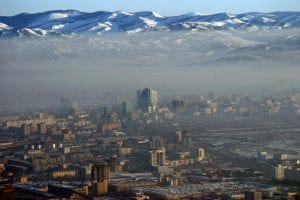Air Pollution and Ulaanbaatar
What is Air Pollution?
Before going into the issue in Ulaanbaatar, it is important to understand the basic concept of what this blog is discussing, that is, air pollution.
“The presence of toxic chemicals or compounds (including those of biological origin) in the air, at levels that pose a health risk” (What is Air Pollution?, 2017)
How does this relate to Ulaanbaatar?
The capital of Mongolia is Ulaanbaatar. Literally translated, Ulaanbaatar means “red hero”, however, disgruntled Mongolians have taken to calling it Utaabaatar which means “smoke hero” (Sorace & Jargalsaikhan, 2019), as the levels of pollution in this city has reached extremely high levels.
Ulaanbaatar accounts for about 46% of Mongolia’s air pollution (Air pollution in Mongolia, 2019), and according to the 2018 UNICEF report, its pollution levels had reached 3,320µg/m³ (Timsit, 2019) which is a whopping 133 times higher than the recommended average concentration (Gheorghe, Ankhbayar, & van Nieuwenhuyzen, 2018). Additionally, being a land-locked nation, it does not have the benefit of the ocean being a moderator for its pollution effects (Denyer, 2018).
As one would expect, this level of pollution is not without damage, and it has seen its effects in the increase in number and severity of health issues, especially among young children (Davaasharav, 2019).

- Guttikunda, Sarath K. et. al. (2013). Twenty-four-hour average PM2.5 concentrations by month from a monitoring station located at the National Institute of Meteorology and Hydrology, Ulaanbaatar, Mongolia [Graph]. Retrieved from https://link-springer-com.ezlibproxy1.ntu.edu.sg/article/10.1007%2Fs11869-013-0198-7
These pollution levels are at its’ peak during winter months as the heavy smog comes from the burning of raw coal (and other forms of waste) used to keep Mongolians warm (Davaasharav, 2019), as temperatures can drop to as low as -50 degrees Celsius (Yakupitiyage, 2019).
This is a dire problem if action is not taken soon, as costs to recover would continue increasing, and it would be even harder to reverse the damage already done. Therefore, my purpose in creating this blog is to raise awareness of this issue.
